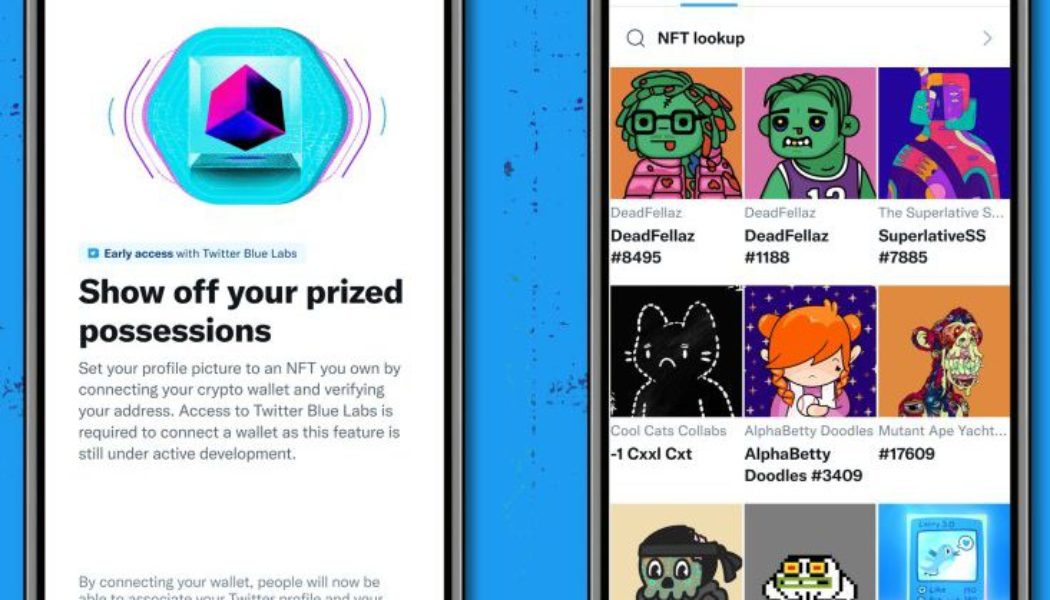
Today, just four months after announcing it was exploring the idea, Twitter began letting some people use non-fungible tokens as their profile pictures. Subscribers to the $2.99-a-month Twitter Blue service can now connect a crypto wallet, and display any NFTs they own in their profile. These users are easily distinguished from those yet to be crypto-pilled by the shape of their avatars: a hexagon, rather than the traditional circle.
In September, when Twitter first broached the idea, I suggested that the company’s adoption of NFTs could take the technology mainstream. Twitter users already invented the hashtag, the @ mention, and the retweet; by using profile pictures to display their (unauthenticated) NFTs already, I argued, owners of CryptoPunks, Bored Apes and other popular collections had invented the NFT profile. And now here it is, as an official Twitter product.
In accordance with the polarizing nature of blockchain-based projects in general, Twitter’s introduction of NFT profiles was met with significant disdain. Recent criticism of NFTs has highlighted the degree to which the technology does not live up to its own promises: of decentralizing power, or even of verifying ownership. (For the most part, NFTs today do not encode the owned media on the blockchain; rather, what is encoded is essentially a receipt for it.) Viewed through this lens, Twitter could be accused of legitimizing a technology that can leave people open to theft, scams, and other dangers.
At the same time, millions of people are about to begin seeing those hexagons every day and wonder what the fuss is about. The question is whether Twitter — and all the other platforms racing to build NFT integrations — can brute-force digital collectibles into popularity, over the strident objections of critics.
As it so happens, we’ve had an early test of that question in the gaming industry. Over the past several months, several top developers have announced plans to integrate NFTs into their games, in the form of digital goods. The resulting stories generally include the phrase “massive backlash.”
Gamers’ complaints are straightforward. The gaming industry has gradually shifted from a model of charging you a one-time fee to own a game to one in which you might be asked to pay for it multiple times (to download new expansions, or buy cosmetic items); or continuously (via subscriptions). Loot boxes, which award players items at random, introduced an expensive and much-hated form of pseudo-gambling into the gaming world. As a result, gamers often feel nickel-and-dimed by developers, without the games generally feeling more fun as a result.
The idea that playing a video game in the future might involve connecting a crypto wallet, paying steep fees just to transact on the marketplace, purchasing scarce digital goods, and then working to protect them from thieves — well, it’s not clear how that would make games much more fun, either. (One of my favorite YouTubers, the game critic SkillUp, now has a recurring feature about NFTs in his weekly round-up of games news: it’s called “No Fucking Thanks.”)
And so Ubisoft was roasted after announcing a plan to put NFTs into its shooter game Ghost Recon Breakpoint. Square Enix, maker of the Final Fantasy series and others, drew criticism for suggesting that it could “potentially” offer crypto tokens in the future. Mobile gaming company Zynga seems to have avoided much backlash for hiring a blockchain chief, but then Zynga games have been built on asking players to make constant, frustrating transactions from the start.
For would-be operators of thriving NFT trading platforms, this backlash represents more than a series of negative public relations cycles. Silicon Valley’s collective vision of the next version of the internet, the one we have taken to calling the metaverse, hinges on video games as the thing that will lure the masses to buy augmented and virtual reality headsets. The basic idea, as Mark Zuckerberg articulated to me last summer, is that you’ll buy virtual clothes or other digital goods as NFTs, and take them from VR experience to VR experience, starting with games.
If players continue to hate the idea of NFTs forever, then, the metaverse will look very, very different. And developers that have raised funds at sky-high valuations based on the idea that games will bring billions of people onto web3, such as the team behind Axie Infinity, will suffer.
It’s not just players who are skeptical. In a survey published today by the Game Developers Conference, 70 percent of studios said they have “no interest” in NFTs. Here’s Jay Peters at The Verge:
“When asked how they felt about the possibility of cryptocurrency or NFTs in games, a few called it ‘the future of gaming,’” the survey said. “However, a vast majority of respondents spoke out against both practices — noting their potential for scams, overall monetization concerns, and the environmental impact.”
Many quotes directly from developers were scathing. “How this hasn’t been identified as a pyramid scheme is beyond me,” one wrote. “I’d rather not endorse burning a rainforest down to confirm someone ‘owns’ a jpeg,” said another. “Burn ‘em to the ground. Ban everyone involved in them. I work at an NFT company currently and am quitting to get away from it,” said another.
Of course, another way of reading this data is that almost one-third of game developers today say they are at least interested in NFT integrations. But for now, at least, they are in the minority.
All of which brings us back to the question of how these dynamics will play out on Twitter. There are some important differences between games and tweets: gamers hate NFTs in large part because they feel they fear they will be forced to buy them; on Twitter, buying and displaying any digital art that you purchase will be optional. And while the audience for video games numbers in the billions and defies easy categorization, I imagine Twitter’s diverse audience may have an even wider range of reactions to NFTs in the timeline.
Today I saw reactions of two kinds: from crypto skeptics, dunking on hexagons; and, from crypto enthusiasts, dunking on people who are mad at hexagons.
Who will prevail?
Sometimes, a technology is so reviled from the start that it is driven out of polite society. Ask anyone who wore Google Glass into a bar in 2013 how that worked out.
Other times, though — and this feels especially true on Twitter — things get ridiculed into legitimate popularity. (People who research extremism have a term for the way jokes are often used to smuggle ideas into the mainstream: irony poisoning.) And crypto enthusiasts have been masterful at co-opting insults hurled at them into badges of honor. When critics derided their art works as “JPEGs,” for example, the community quickly began using that term — with a wink — to refer to their collections.
If Twitter can’t take NFTs mainstream alone, it won’t be the last to try. The Financial Times reported on Thursday that Meta plans to let people create and sell NFTs on its platforms. Google now officially has a blockchain team as well, and surely YouTube will fit into its plans.
It’s far too soon to gauge the prospects of any of these efforts, which remain in their earliest stages. But in the meantime, we may look back on Twitter’s hexagon launch as the day NFTs became accessible to a broad, mainstream audience.
Now we wait to see whether the mainstream actually wants them.









